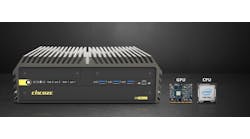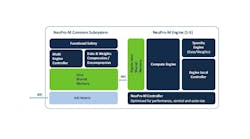Recently, I was on vacation with my wife in the “happiest place on Earth”—Walt Disney World in Florida. Last year was a write-off for most of us, dealing with a pandemic of epic proportions. For some, like myself, Coronavirus D-19 (COVID-19) was personal. I started getting sick in early August 2020 and, within three or four days, found myself in an intensive-care-unit (ICU) ward at our regional hospital. Through shear willpower, I managed to stay off of a ventilator but still spent 15 days in a COVID-19 ICU before finally moving up to a ward for another three days of recovery. While there are some lingering issues, for the most part I am past all the bad stuff and happy to be alive.
There is a stark contrast between last year and this year that I can barely put into the proper words, but I think I can best describe myself as a survivor. I truly hope that all of you can say the same as we continue to deal with this specter, nearly two years after it first began its march around the globe.
My wife and I spent the day at the Magic Kingdom. It has been a tradition for her since 1972 and became a part of my life when I made my first visit about eight years ago. For most who visit this magical place, the lasting memories are of the attractions and all-encompassing hospitality that is Disney. I would suggest that no one does it better. While I had an awesome time, I found myself doing what I always seem to be doing. I was thinking about automation.
For those who know me personally, I’m sure you would think nothing less of me. It has been my life for more than 30 years, and I really can’t lay my head down at night without some level of automation thought process in the pipeline to Neverland.
While my wife was happily sitting beside me through It’s a Small World, The Haunted Mansion and The Hall of Presidents, I was drinking in all of the wonder behind the scenes. For instance, how did all of the various characters in the small world all move along in time with the song? What magic was at work to keep them all in sync?
The most amazing of the Disney marvels, at least to me, is the automatons in attractions such as The Hall of Presidents. They are so lifelike, and their motions are perfectly choreographed into the presentation of the story that takes us from George Washington through the most recent president. The answer, of course, points back to programmable controllers.
I’m sure much has changed over the years, but the approach really hasn’t changed at all. The Carousel of Progress, for example, was first introduced at the 1964 New York World’s Fair.
The premise of the attraction is to chart the history of innovation, starting with the invention of electricity and how all of the wonderful discoveries over the generations has brought us to where we were today. Now, as one can imagine, the original attraction at the World’s Fair covered roughly 60 years of technological progress. The attraction gets new updates periodically to keep it current—the most recent one was in 1993 and features a final scene suggesting what Christmas would be like in the year 2000—but just imagine how much has happened since that 1964 premiere. Why, there wasn’t even a device called a programmable logic controller (PLC), and yet in 2021 we couldn’t do what we do if it wasn’t for that magical little device and its offspring, the programmable automation controller (PAC) and the programmable computer (PC).
It might surprise some to learn that the first programmable computer, the electronic numerical integrator and computer (ENIAC), was actually built during World War II, roughly 20 years before that Carousel of Progress came to life. The journey, it would seem, started long before many of us were born, so, as it turns out, one of the children mentioned above is actually the parent.
I lingered with the theme of The Carousel of Progress because it really drives home the point that there is a lot to be proud of when it comes to technological innovation. It’s not much of a stretch to say that, with the exception of Nicola Tesla, most of the earlier inventors, such as Thomas Edison and George Westinghouse, had no idea that their work would lead to the wonderful inventions that we use today.
Tesla, for me, remains the tip of the sword when it comes to what lies before us. Truly a visionary. The light bulb, for example, seems commonplace today, but what an illuminating—pun intended—discovery it was for that time. Since then, we’ve seen ringer washers, electric ice boxes (refrigerators), radar, televisions, personal computers, wireless communications, a thing called the World Wide Web and now a device that you can hold in your hand and connect to that World Wide Web via a wireless network, giving you access to the knowledge of everything that mankind has ever done, ever.
PLCs are, perhaps, becoming a legacy device. Much more powerful, the PAC is a wonderful melding of the logic controller with the sibling—or is it parent?—PC. The more recent version of a PAC can combine logic and safety in the same physical device. Some even have dual processors, with one dedicated to logic and the other to strictly safety functions, providing a truly integrated device.
I have been lucky to stop a couple of times along this journey of discovery and pick up a few programming languages. While I fear that I have fallen behind in this, there was a time when COBOL, FORTRAN, C and its many iterations, Visual Basic, Pascal and Prolog were the lights spinning in my mind each night. I have always thought they were distinct beasts from the ladder logic and statement list of a PLC.
Reluctantly, I can no longer say that this is the case. I have always realized that true programming languages were far more powerful than the representation of an electrical circuit—ladder logic. I really didn’t come across a reason to jump over into the realm of structured text. This probably happened because my focus has always been on the moving machinery of automation and not the land of process control.
The journey, it seems, has come full circle. With the continuing development of the PAC, control algorithms are no longer restricted by the use of ladder logic.
Most PACs include either modules or core memory space to program in a structured text environment. Complex programs and subroutines can now use a combination of higher-level languages and good old ladder logic.
This has led back into the world of programmable computers where structured text has formerly reigned supreme. If one doesn’t need a physical device built to live in a manufacturing environment to control a machine or process, then the PC is the next logical choice in the evolution of control.
With all that said, I think the demise of the PLC and, eventually, the PAC are far off yet. We humans are strange creatures. While we embrace a vision of the future, we tend to hold on to the past. After all, why fix it if it isn’t broken?
I’m afraid I am a contributor to this tendency to lag. I take great pride in creating control systems that can do all of these wonderful things, all the while knowing deep down that the same things can be done with the newer technology in shorter time and probably at less cost.
One recent example of this for me was the discovery of an instruction in my favorite PAC that provides a direct link to an object, for lack of a more sufficient term, on the operator station for alarms and tagging.
The darned thing lets you put all the logic in to not only trigger the alarm but disable it when desired, ignore it when desired and group it with other alarms of a similar type or scope. The programming instruction even has a string tag for the actual text that will display on the operator screen.
I’ve come up with some creative ways, over the years, to make my controller and operator screen interact in such a manner, but, I confess, it took me hours of coding to accomplish. I’ve always been proud of this ability but I now realize that I’ve ignored this “new” technology for several years while I was mired in the “if it ain’t broke, don’t fix it” mentality.
While I am often inspired by technology, this particular column was inspired by a man who, at his lowest point in his life, was reduced to living in an abandoned room where he made friends with a little mouse. That mouse would one day become a symbol of one of the largest corporations on Earth.
Inspiration is always out there if we are willing to look beyond what we see and begin to envision what can be. The spinning carousel that is progress is perpetually reinventing itself. The world that saw a computer that was the size of a room become a device that fits in the palm of your hand will continue to provide evidence of the evolution of mankind. What will be your inspiration?






